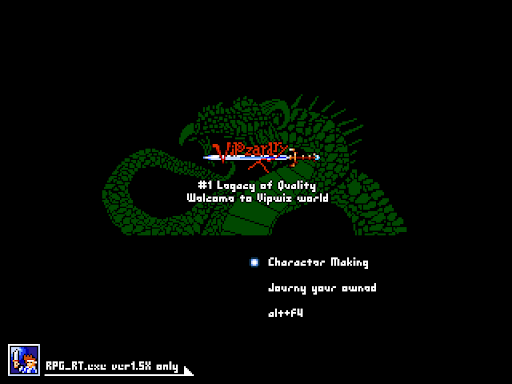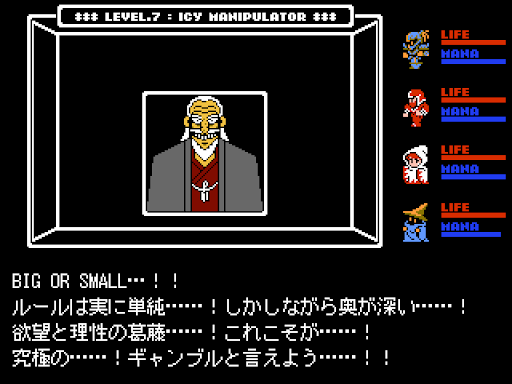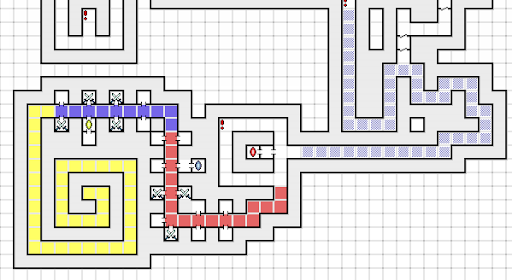Untap Upkeep Draw Mori Set Llanowar no Elf Dashite Turn End - Review
Untap Upkeep Draw Mori Set Llanowar no Elf Dashite Turn End (アンタップアップキープドロー森セットラノワールのエルフ出してターンエンド), aka Vipzardry; Kuso Kote Shine (くそこてしね)
2006, PC
No, really, that's its official title. It was submitted to the '06 VIPRPG Summer Festival under that name, and @wiki lists it by the same. The title screen and game window, however, call it Vipzardry, which is somewhat less of a mouthful. Created by Kuso Kote Shine, it's a first-person DRPG in RPG Maker 2000—not necessarily the first, but certainly the earliest I've played, predating Cirnozardry and Rothdam by several years.
Its most unusual characteristic is its job system. Initial party creation is similar to Final Fantasy I, the player selecting a job for each of the four characters—though there are only four options, Warrior, Thief, White Mage, and Black Mage. Any character can be reclassed to any job at any time, assuming they meet the stat requirements; in addition to the starting jobs above, there are four advanced jobs, Knight, Mystic Knight, Ninja, and Red Mage. A reclassed character's level and stats are reset, but they keep their abilities, which are learned upon reaching certain levels in a job. The trick is that a character can only remember eight abilities at a time, and there's no remembering forgotten ones; this limit is brutally punishing for spellcasters, who not only learn more abilities than anyone else, but must balance in-battle options with out-of-battle utility spells. At least spell-type abilities can also be learned via scroll, so if you delete a spell and regret it, you can get it back. With anything else, you're out of luck unless you feel like reaching the level the ability is learned at again, which, if you haven't reclassed in the meantime, would mean reclassing twice just to reset your level to 1.
Different classes learn their last abilities at different levels, saving the player from reclassing everyone at the same time and being left with a party of first-level weaklings. This is taken to an extreme with the Black Mage, who learns its ultimate ability, Wish, at Lv. 40. For comparison, the Warrior learns its last ability at Lv. 18, the White Mage around Lv. 30, and the Ninja (only the silver medalist in this category, despite being an advanced class!) in the mid-thirties. By the time my fourth character had mastered Black Mage, my others had mastered their second jobs, I had fully explored every floor, and I had spent a couple of hours grinding levels I really didn't need to beat the game. The punchline: I never even cast Wish because, as in Wizardry, doing so costs a level. Womp womp!
Annoyingly, two of the most obvious job paths, Warrior-to-Knight and Warrior-to-Magic-Knight, are actually quite bad; all the Warrior's abilities do is grant a character access to various equipment categories regardless of job—equipment categories the Knight and Mystic Knight have full access to anyway! Everyone else learns something guaranteed to be helpful; the mages get a couple of unique spells and the Thief can steal, untrap chests better, and reduce the random encounter rate. But setting aside these small annoyances, the system works.
As you likely noticed, the job sprites are cribbed from Final Fantasy III. The game blends them with monsters and (if Light is active; if not, enjoy your wireframes) dungeon walls from the Famicom Wizardry ports, SFX from Dragon Quest, and BGM from various Nintendo games (mostly Legend of Zelda, but I caught some Super Mario RPG too). It all fits together better than you'd expect.
Vipzardry also features a uniquely atrocious implementation of doors. In DRPGs, opening a door traditionally transports you instantly to its far side, which is either one cell ahead (in games with 'thin' walls that exist between cells, like Wizardry) or two cells ahead, the door itself occupying a full cell (in games with 'thick' walls made up of full cells, like Etrian Odyssey). In thick-walled Vipzardry, doors do occupy cells, but opening a door places you one cell ahead, inside the door cell. Coming from other DRPGs, this is incredibly confusing at first, especially given that (1) the door is invisible while you're in it; (2) the Accept button can be used to enter doors but not to otherwise move forward; (3) for some reason, your coordinates aren't updated until you leave the door; (4) entering a door frequently triggers a fixed battle, and by the time it ends you may have forgotten you entered the door in the first place. I eventually got used to it, but not before it introduced an annoying off-by-one error into my map of the first floor.
The dungeon, while not as exquisitely balanced as some games', is varied and amusing, particularly the large navigation puzzle occupying the fifth and sixth floors. Most of the fifth floor is taken up by a large, seemingly empty room; upon attempting to advance, however, you'll find that it's full of invisible chutes that drop you to the sixth. The key is to find the four maps depicting the chute layout and copy them over to your map. The first is given as a freebie as you enter the room, and the second isn't far away, but the third is on the next floor, and the fourth is inside the region revealed by the first three. Technically, I believe this whole puzzle is optional, but it rewards you with an item that can be combined with another to get a rare accessory that permanently increases a character's stats when they change jobs. More importantly, it's an amusing challenge.
Unless you brought a wizard. There are spells to continuously display your coordinates and facing; see an overhead view of the area around your character (also available via the "VIP Mode" option, if you'd rather have it from the start); and view a massive region of the map centered on your current position (including tiles you haven't explored yet). The latter two display chutes and thereby let you completely circumvent the puzzle. You could always not use them, of course—and with limited ability slots, there is an advantage to be wrung out of forgoing them.
(Speaking of maps, it's absolutely essential that you use a digital mapping tool like Graph Paper, not physical graph paper: some floors are too big to fit on a single sheet, and there's no way to tell how large a given floor will be until you reach the far edge. We're talking upward of 50x50!)
Another spell offers coordinate-based teleportation to any cell of your choice (event squares and the final floor excepted). At one point I teleported to (7,7,7), an odd closed-off area I noticed with the mapping spell, and entered a secret casino run by the guy from Kaiji. I proceeded to turn 1,000 GP into 16,000, which would've destroyed the economy if I had any use for money at that point (like in Wizardry, the only stock the shop gains is what you sell it; additional shops exist in the dungeon, but the ones I found only sold spell scrolls).
Cute touches like that are common. The first floor, the Orcish Fortress, has a kobold in a side room who sends you to kill the Orc Lord. Should you do so and return..
Later floors offer NPCs who offer advice and simple side quests. Amusingly, every NPC can be robbed or fought, if you so choose. I didn't bother, aside from stealing a cell key from one character to free another, but simply having the option makes the game feel more expansive.
And there are things I didn't even experience: I barely touched the crafting system, which lets you combine reagents to create consumable items (plus at least one piece of equipment, the Crystal Fragment, which is consumed upon changing jobs in exchange for a huge boost to one starting stat); the credits sequence implied the existence of a bonus boss that I didn't really feel like hunting for; and B9F had an incredibly long and elaborate path signposted "Palace of the Dead" that led to, for all I could tell, absolutely nothing.
If Vipzardry has one flaw (nothing above is more than a quibble, not even the doors), it's that it's a bit too gentle. The utility spells are ignorable enough, but the dungeon simply isn't very mean. Moreover, while the party starting with single-digit HP makes combat laughably deadly at first, I felt vastly stronger than the enemies once I had a few levels under my belt; that didn't go away until the final hours of the game, where enemies started to pull properly nasty tricks like full-party confusion. Still, being a bit easy is hardly enough to ruin the game.
The developer went on to release at least one other game: 2007's Diver Down, a rather strange quasi-roguelite where you buy abilities and stat upgrades with your maximum HP.
Links















Found this really interesting. Thank you for sharing and documenting your experience so extensively.
ReplyDelete